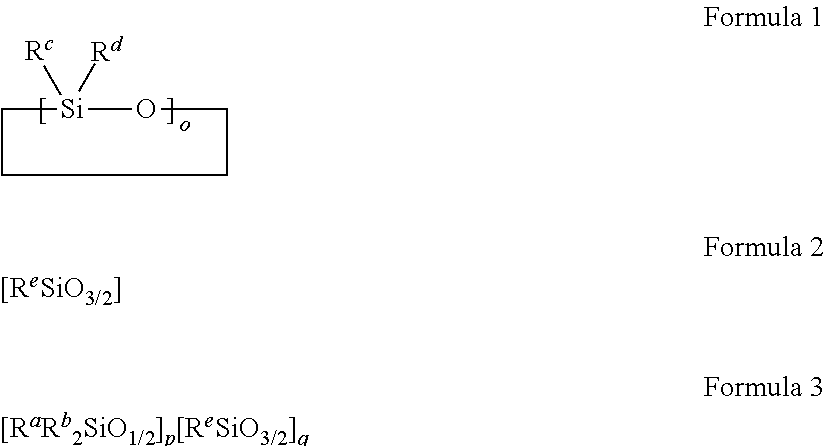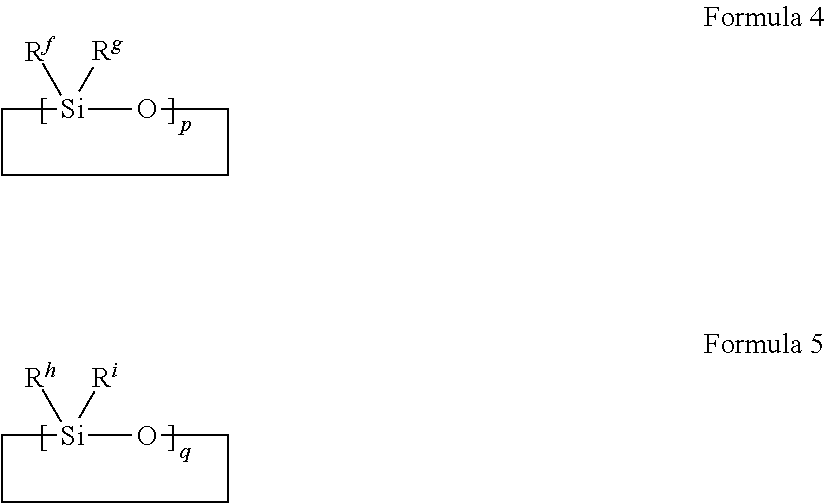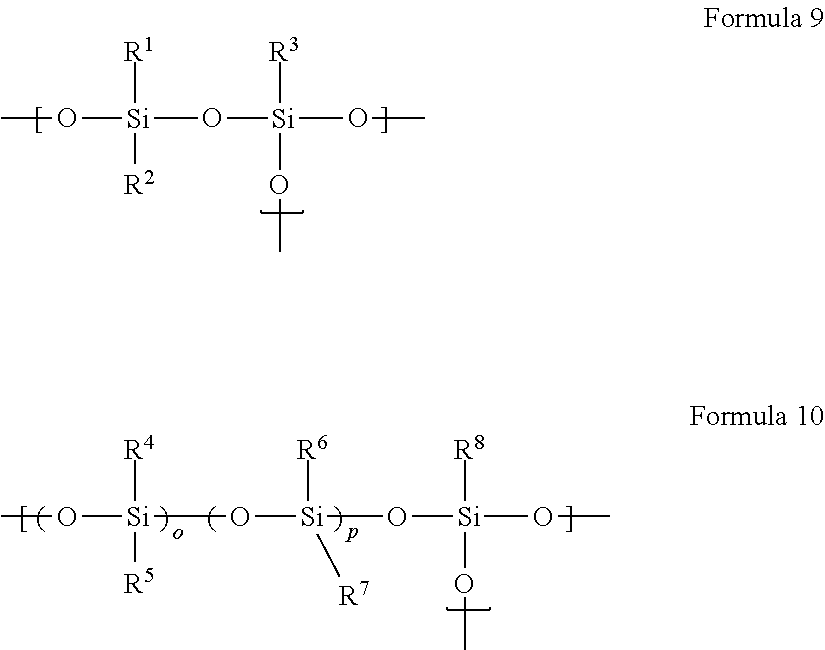Method for producing organopolysiloxane
a technology of organopolysiloxane and polysiloxane, which is applied in the field of preparation of organopolysiloxane, can solve the problems of difficult preparation of the inability to effectively prepare an organopolysiloxane having a desired structure using this method, and the inability to achieve the trifunctional siloxane unit by means of oxygen atoms, the inability to
- Summary
- Abstract
- Description
- Claims
- Application Information
AI Technical Summary
Benefits of technology
Problems solved by technology
Method used
Image
Examples
example 1
[0101]60.00 g of octamethylcyclotetrasiloxane, 106.96 g of octaphenylcyclotetrasiloxane, 17.44 g of octaphenyl-polyhedral oligomeric silsesquioxane (octaphenyl-POSS) and 12.56 g of divinyltetramethyldisiloxane were mixed, and 0.63 mL of tetramethylammonium hydroxide (TMAH) was mixed with the resulting mixture as a catalyst. Thereafter, the mixture including the catalyst was reacted at a temperature of 115° C. for approximately 20 hours to obtain a polysiloxane in the form of a transparent oil, which was represented by the following Formula A. The polysiloxane had a viscosity at 25° C. of 21,000 cP and a molecular weight of approximately 6,400. Also, the peak derived from an alkoxy group was not observed on the spectrum as measured using a 1H-NMR assay, and the acid value was measured to be approximately 0.006 mg KOH / g.
[ViMe2SiO1 / 2]2[Me2SiO2 / 2]22[Ph2SiO2 / 2]15[PhSiO3 / 2]5 Formula A
example 2
[0102]A polysiloxane was synthesized in the same manner as in Example 1, except that the divinyltetramethyldisiloxane was blended at a content of 6.28 g. The polysiloxane was represented by the following Formula B, and prepared in the form of a transparent oil. Here, the polysiloxane had a viscosity at 25° C. of 58,600 cP and a molecular weight of approximately 9,700. Also, the peak derived from an alkoxy group was not observed on the spectrum as measured using a 1H-NMR assay, and the acid value was measured to be approximately 0.009 mg KOH / g.
[ViMe2SiO1 / 2]2[Me2SiO2 / 2]40[Ph2SiO2 / 2]27[PhSiO3 / 2]9 Formula B
example 3
[0103]A polysiloxane was synthesized in the same manner as in Example 1, except that the octaphenyl-POSS and the divinyltetramethyldisiloxane were blended at contents of 34.88 g and 15.72 g, respectively. The polysiloxane was represented by the following Formula C, and prepared in the form of a transparent oil. Here, the polysiloxane had a viscosity at 25° C. of 33,200 cP and a molecular weight of approximately 4,600. Also, the peak derived from an alkoxy group was not observed on the spectrum as measured using a 1H-NMR assay, and the acid value was measured to be approximately 0.008 mg KOH / g.
[ViMe2SiO1 / 2]2[Me2SiO2 / 2]19[Ph2SiO2 / 2]12[PhSiO3 / 2]6 Formula C
PUM
| Property | Measurement | Unit |
|---|---|---|
| temperature | aaaaa | aaaaa |
| acid value | aaaaa | aaaaa |
| temperature | aaaaa | aaaaa |
Abstract
Description
Claims
Application Information
 Login to View More
Login to View More - R&D
- Intellectual Property
- Life Sciences
- Materials
- Tech Scout
- Unparalleled Data Quality
- Higher Quality Content
- 60% Fewer Hallucinations
Browse by: Latest US Patents, China's latest patents, Technical Efficacy Thesaurus, Application Domain, Technology Topic, Popular Technical Reports.
© 2025 PatSnap. All rights reserved.Legal|Privacy policy|Modern Slavery Act Transparency Statement|Sitemap|About US| Contact US: help@patsnap.com



